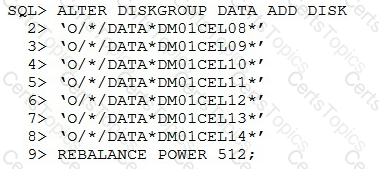You want to examine how much Smart Scan activity is occurring.
Which two would provide the information you require?
Your customer would like to configure monitoring capabilities Auto Service Request (ASR) on the stand-alone server that was set aside to run ASR Manager.
What configuration should you set up for the customer?
What is the minimum Oracle Linux version required to support RoCE and Persistent Memory?
Which two options can be used to identify a damaged or failing flash card on an X9M-2 Database Machine High Capacity storage server?
What type of SRs does the ASR Manager generate for Exadata?
You are concerned about the operating temperature of the database servers in your Exadata Full Rack and want to be alerted if the server exceeds 30C.
What command should use use to generate alerts for such an event?
Which four actions should you take before proceeding with applying updates to your Exadata Database Machine?
You are in the process of upgrading your nonvirtualized X9M-2 Database Machine elastic configuration with 4 database servers and 7 HC storage servers with an additional 4 database servers and 7 HC storage servers.
The new storage servers are called DM01CEL08 through dmoicel14.
After creating 96 new griddisks, you issued this SQL statement:

How many failgroups if any, will be added to the DATE diskgroup by executing this SQL statement?
You are hardening the security posture of your Exadata Database Machine. Before disabling ssh access to the storage servers, what should you do to enable REST access to the MS process?
Which two Exadata security features would you configure to control which databases can access which griddisks, when multiple databases share space on your storage servers in an unpartitioned storage grid?
Which two statements are true about enabling write-back flash cache?
Which of the below is NOT a precaution that should be adhered to in order to ensure the site is safe and ready for
An Exadata X9M-2 Elastic Rack with 4 Database Servers and 8 HC Storage Servers and 3-phase 24kVA PDUs is being installed in a Data Center. However, the Data Center is only providing enough power for a single cable from each PDU. Which statement is correct?
A new Exadata Quarter Rack with 2 Database Servers and 3 HC Storage Servers and 3-phase 15kVA PDUs is being installed in a Data Center. However, the Data Center is only providing enough power for a single cable from each PDU.
Which statement is correct?
Which two statements are true about applying updates on Exadata systems?
Which two activities are supported on the storage servers in an Exadata Database Machine?
Which two statements are correct about adding an additional database server to a physical Exadata X9M Database Machine using Oracle Exadata Deployment Assistant (OEDA)?
What is the maximum DRAM capacity you can expand an X9M-2 DB Server?
Which statement is true about the disks that are used in ASM diskgroups on the Exadata platform?
Which two quarantine types can disable Smart Scan for multiple databases that offload SQL statements to a cell on an Exadata Database Machine?
Which two statements are false about backup to ZFS Storage Appliance (ZFSSA)?
Which statement is true about the Persistent Memory Commit Accelerator?
Which two statements are true about the IPTables firewall configuration on a new Exadata Database Machine after initial deployment?
Which two of the following network connection types can be deployed on the client network ports of an Exadata X9M-2 Database Server?
An Exadata storage server physical disk on an X9M-2 high-capacity full rack entered the predictive failure state. Which two steps must you perform to replace this failed physical disk?